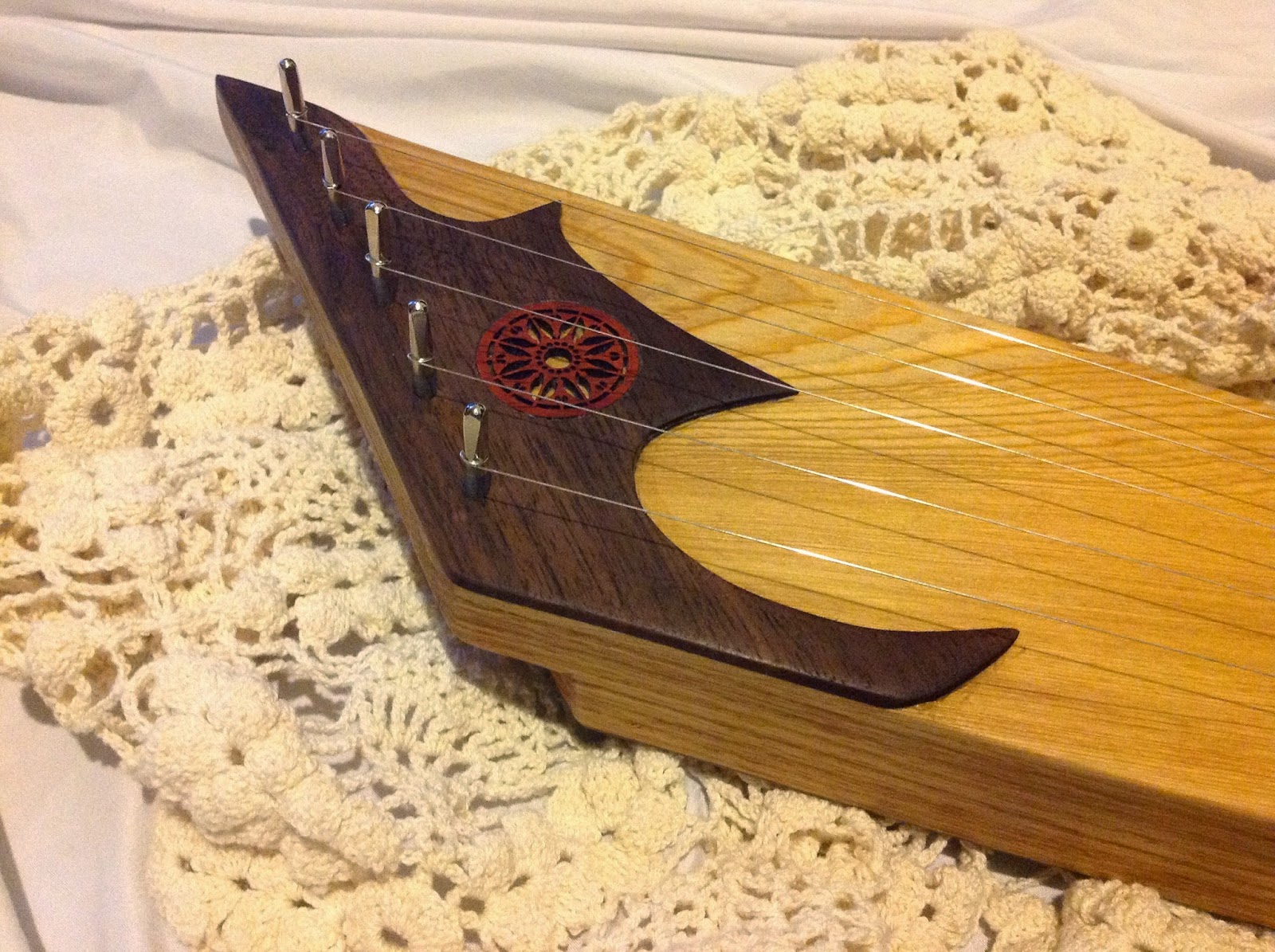 This kantele was my first kantele, the beginning steps into my journey into not only the world of the kantele, but better instrument making in general. I finished this one in January, and am quite pleased with the results. You can click on the thumbnail photos for larger detailed pictures. This kantele uses red oak sides and tuning peg shelf, which was leftover wood I had bought from The Home Depot for another project. The front part under the ponsi is a bit of leftover mahogany from wood I had used for a traditional bow many years ago. The ponsi and decorative headplate consist of black walnut, with a thin stripe of padauk at the bottom of the ponsi, and a very nice little padauk rosette which I bought from Folkcraft Instruments, inlaid into the headplate. The backboard also consists of black walnut with a single 1.5" diameter sound hole.
This kantele was my first kantele, the beginning steps into my journey into not only the world of the kantele, but better instrument making in general. I finished this one in January, and am quite pleased with the results. You can click on the thumbnail photos for larger detailed pictures. This kantele uses red oak sides and tuning peg shelf, which was leftover wood I had bought from The Home Depot for another project. The front part under the ponsi is a bit of leftover mahogany from wood I had used for a traditional bow many years ago. The ponsi and decorative headplate consist of black walnut, with a thin stripe of padauk at the bottom of the ponsi, and a very nice little padauk rosette which I bought from Folkcraft Instruments, inlaid into the headplate. The backboard also consists of black walnut with a single 1.5" diameter sound hole. The soundboard took me a while to decide upon. Often times, woods like poplar are used. Its a relatively soft wood, and good choice for soundboards, but I wanted something with more grain character. Pine is ok, but still a bit lower quality and dull for what I was intending. Spruce, particularly sitka spruce, is often hailed as one of the best quality soundboard materials for stringed instruments. It is a bit harder to find smaller pieces for kantele however, and still has a bit boring (in my opinion, compared to other woods out there) grain pattern. Its also used on many, many guitars, and I wanted something a bit different and less common. After doing some searches and comparisons, I found that cypress has a very nice grain look, and has very good soundboard characteristics. From the Wood Database, here are some general stats on the wood:
The soundboard took me a while to decide upon. Often times, woods like poplar are used. Its a relatively soft wood, and good choice for soundboards, but I wanted something with more grain character. Pine is ok, but still a bit lower quality and dull for what I was intending. Spruce, particularly sitka spruce, is often hailed as one of the best quality soundboard materials for stringed instruments. It is a bit harder to find smaller pieces for kantele however, and still has a bit boring (in my opinion, compared to other woods out there) grain pattern. Its also used on many, many guitars, and I wanted something a bit different and less common. After doing some searches and comparisons, I found that cypress has a very nice grain look, and has very good soundboard characteristics. From the Wood Database, here are some general stats on the wood: - Janka Hardness: 510lbf
- Average Dried Weight: 32lbs/ft^2
- Specific Gravity: 0.42
- Elastic Modulus: 1,440,000 lbf/in2 (9.93 GPa)
 I made this kantele as a 5 string instrument, 24" long, and a little wider at 5". I wanted to experiment with a wider model 5 string instrument and play around with wider string spacing than normal.
I made this kantele as a 5 string instrument, 24" long, and a little wider at 5". I wanted to experiment with a wider model 5 string instrument and play around with wider string spacing than normal.With my kanteles, I also want to create a unique and distinct style of my own. This design came about from a combination of both a lack of tools at the time, and a want to explore new styles, which has stuck with each kantele so far. One major difference with my kanteles is the shape: the front is pointed as opposed to the traditional round ponsi end. I did this for ease of construction, which also happened to fit well with my kantele themes. Another unique feature is the carved ponsi. Each kantele has its own theme, represented by the decorative headplate at the tuning peg end, and the ponsi. I have added what I like to call "dragon flairs" on the ponsi, giving them more distinct flavor as opposed to the more traditional simple straight or slightly rounded ends on the ponsi. My kantele are also heavier than normal, using thicker woods for the frame. I have always preferred the feel of a heavier instrument, and as this thickness is most commonly available (3/4" thick), I have decided to stick with it.
Most kanteles I have seen use relatively simple woods, such as birch, pine, poplar, mahogany, and walnut. These are great and relatively inexpensive woods to start with, with woods like birch having cultural significance in the folk roots of traditional kantele making. I wanted to expand and use more exotic choices, adding things like contrasting strips on the sides, and unique carved themes and accents. My later kanteles reflect this, with more exotic choices with each one I make. Stay tuned for sound clips and a playing description of this kantele in upcoming posts!
Extra Sources and Info:
1.) The Wood Database: http://www.wood-database.com/
2.) Folkcraft Instruments: http://www.folkcraft.com/search.html?sep=rosette&sed=128
3.) D&D Hardwoods: http://www.dndhardwoodsonline.com/


No comments:
Post a Comment